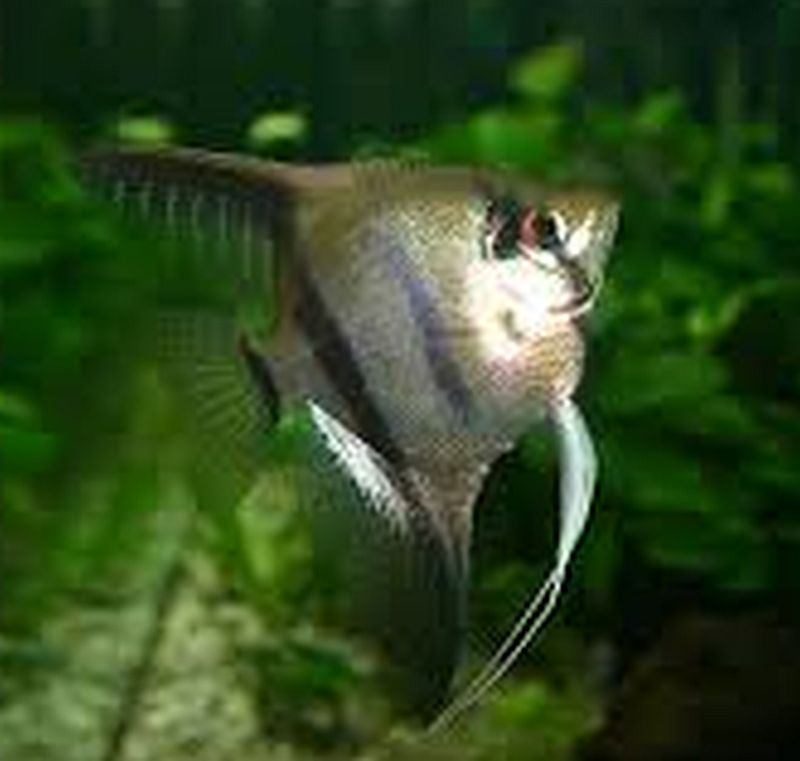The Silver Zebra Angelfish (Pterophyllum scalare) like all Pterophyllum species, originate from the Amazon River Basin, Orinoco Basin, and various other smaller rivers in the Guiana Shield in South America. They are a member of the family Cichlidae (Cichlids) and are all collectively known to tropical fish keeping enthusiasts as Angelfish.
In their natural environment, Silver Zebra Angelfish live in swamps and flooded areas around dense vegetation in either clear or silty colored water. They are usually found among bulrushes and around underwater brush where they can quickly dart to shelter. They are a relatively peaceful, social species that are often found swimming in large shoals.
There are three species of Pterophyllum, and are all unusually shaped for Cichlids. They have round, laterally compressed bodies, elongated triangular dorsal and anal fins, and almost all wild specimens are striped longitudinally which provides them a modicum of camouflage. Pterophyllum scalare is the most commonly kept species and no doubt the one most often bred in captivity. Pterophyllum altum is the second most common (usually captive bred) and Pterophyllum leopoldi is the smallest and least often found in the tropical fish keeping hobby.
All Pterophyllum species are egg layers that form monogamous pairs. They generally deposit their eggs on a submerged log or a flattened leaf, and like other members of the cichlid family, exhibit highly developed care for their offspring.
Most Silver Zebra Angelfish purchased in the United States are captive bred and are mostly silver in color, with black or dark brown longitudinal stripes. They posses thin fins that typically extend the entire length of their body.
Silver Zebra Angelfish are considered a community fish by most tropical fish keeping enthusiasts but because they are cichlids, they may not be compatible or as sociable with smaller species. As juveniles they will school peacefully in small shoals but as they grow larger, they will pair off and become increasingly territorial.
Silver Zebra Angelfish should be kept in a densely planted tank of at least 30 gallon capacity, with a sandy or fine gravel substrate, some river rock formations, driftwood roots, and plenty of free swimming space. These fish quickly grow big and tall, and require as much tank space as possible. The general rule for keeping angelfish is to provide 8 or 9 gallons of tank space per fish and because they can become quite territorial as they mature, to keep them in small groups of threes. Six angelfish in a densely planted 55 gallon aquarium would make a nice display tank.
Because they are shy and timid, a densely planted tank is essential to keeping Silver Zebra Angelfish healthy and happy. Amazon sword plants (Echinodorus) or other large leaved plants are preferred to give the fish places to hide, lay their eggs on, and to keep them calm. Some driftwood is also beneficial to maintain water quality and provide them cover.
All Angelfish require good water quality and some water movement. External canister filter are a good choice for this species. In smaller tanks, an outside filter augmented with a small powerhead will also do an efficient job of maintaining water quality.
All angelfish are egg layers that form nuclear families. In the wild they are open breeders and spawn on submerged leaves. Because they are difficult to sex, the best way to breed the Silver Zebra Angelfish is to place a small school of 4 to 8 fish in a tank and let them pair off. They become sexually mature in about 6 to 12 months, usually when they are about 2 inches in length.
Once you identify a pair, place a piece of slate, a flowerpot, or a large leafed plant into the aquarium in an area where there is a moderate amount of water flow where the pair can deposit their eggs. Start conditioning them by feeding them a diet of protein rich foods and keep the water in the breeding tank at a pH of 6.5, a hardness of about 5° dGH, and a temperature of between 80 to 85° F.
When ready to breed, the female will lay about 1000 or more eggs on a carefully cleaned surface. A leaf, angled piece of slate, flowerpot, or the side of the aquarium. When the female deposits her eggs, the male will follow behind her and fertilize them. If the parents don’t immediately eat the eggs, the eggs will hatch in 3 or 4 days and the tiny fry will be free swimming in about a week. Feed the fry newly hatched baby brine shrimp for the first week or two until they are able to eat finely crushed flake food on their own.
If the parents do not immediately eat their eggs, they will carefully guard them and the fry until they are able to fend for themselves. Although the parents will swim around the tank with a shoal of tiny fry in tow until the fry are eating on their own, it’s a good idea to remove the fry into a rearing tank to ensure that the parents don’t turn on them.
Being omnivores, Silver Zebra Angels need to be fed a variety meaty and vegetable based foods. A quality flake food fed as a staple with live, frozen, and freeze dried bloodworms, brine shrimp, tubifex
, blackworms, etc. will keep your angelfish health and happy.
Silver Zebra Angelfish are usually readily available for sale when they are approximately 3/4″ to 3″ in length.
Minimum Tank Size: 30 gallons
Care Level: Easy
Temperament: Semi-aggressive
Aquarium Hardiness: Hardy
Water Conditions: 75-82° F, KH 1-5, pH 5.8-7.0
Max Size: 6″
Color Form: Black, Tan, White
Diet: Omnivore
Compatibility: Community Tanks
Origin: Amazon and Orinoco River Basins
Family: Cichlidae
Life Span: 10-15 years
Aquarist Experience Level: Beginner



